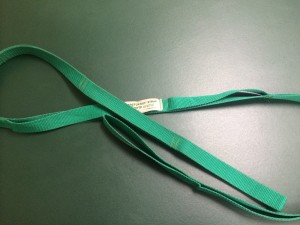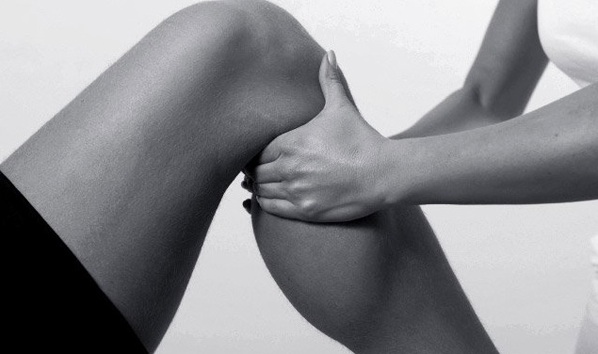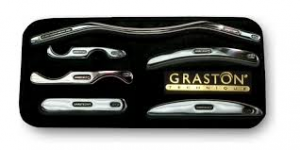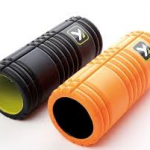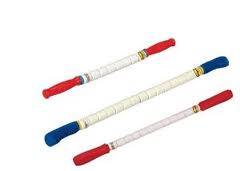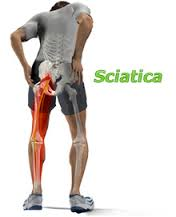 When I first entered the cycling community my main drive was the fact that I couldn’t run without feeling sciatica down my right leg. I had completed all the Orthopedic tests and MRIs and found out it was not disc related. Yet, the weakness and numbness would not subside, so I was extremely bummed that I wasn’t leading an active lifestyle. I was assessed by a physical therapist and told all my issues were being caused due to muscle tightness and muscle imbalances. Alas! An answer to my problem.
When I first entered the cycling community my main drive was the fact that I couldn’t run without feeling sciatica down my right leg. I had completed all the Orthopedic tests and MRIs and found out it was not disc related. Yet, the weakness and numbness would not subside, so I was extremely bummed that I wasn’t leading an active lifestyle. I was assessed by a physical therapist and told all my issues were being caused due to muscle tightness and muscle imbalances. Alas! An answer to my problem.
Cycling is non weight bearing exercise and really helps strengthen my muscles (hip flexor, glute maximus, and hamstrings). Slowly, I began to feel better and was able to do other activities besides cycling; such as: swimming, weight lifting and running. It is important to note that sciatica is not an actual injury rather, a catch all term for an underlying pathology. Sciatica is what alerts us to muscle tightness, muscle imbalances in our hips, disc herniation or impingement, leg length discrepancy, or piriformis syndrome. There is also about 22% of the population which have the sciatic nerve going straight through the piriformis instead of behind it. This makes one more susceptible for sciatica symptoms. If you’re experiencing sciatica and have ruled out a disc injury, then the following tips can be beneficial for resolving symptoms and causes.
SADDLE POSITION
Having the appropriate saddle position is vital for a variety of reasons. If your saddle is too low in relation to your pedals it can cause the hip muscles to be in a constant shortened position. This does not allow the piriformis, hip flexor, glute max, or glute medius to stretch out at any phase of the pedal stroke. When this happens it can lead to compression of the sciatic nerve causing numbness, tingling, and a feeling of general posterior leg tightness when riding. However, this can be fixed by visiting a certified, bike fitting specialist at your local bike shop. There are some companies like Specialized that offer courses to certify bike employees in proper fitting techniques. They use specific body landmarks, plumb lines, and goniometric measurements to ensure the bike is fitted to your needs. Once you’ve adjusted your saddle position you will see a rapid improvement in your symptoms.
It is also important during long rides to pedal off the seat once in a while to allow some blood flow into your legs. When sitting on the saddle for a long period of time, the sciatic nerve is compressed as well as surrounding blood vessels. By pedaling off the seat we relieve the nerve compression and allow an increase in circulation. This can also be accomplished by unclipping one leg at a time and shaking it out to increase blood flow.
MUSCLE TIGHTNESS
If the hamstrings, glute maximus, hip flexor, or specifically the piriformis is tight it can choke the sciatic nerve and cause this nagging pain. It can also cause improper rotation of the hips, which aggravate the sciatic nerve. It is imperative we stretch these muscles before and after riding. These muscles should be stretched ideally 3 times for 20-30 seconds multiple times a day. Using a stretch out strap (pictured below) is beneficial in getting a good hamstring stretch. Below I’ve demonstrated some great stretches for the glute maximus, hip flexor, and piriformis.
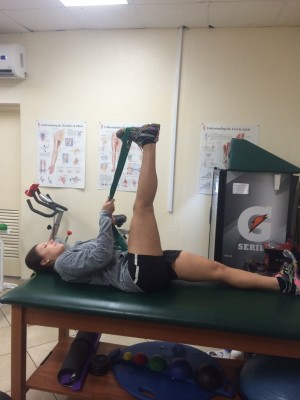
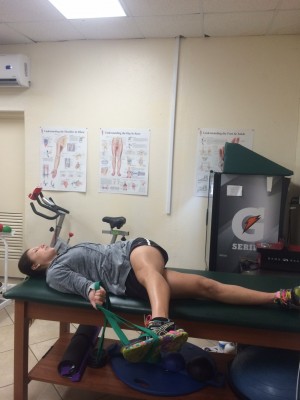
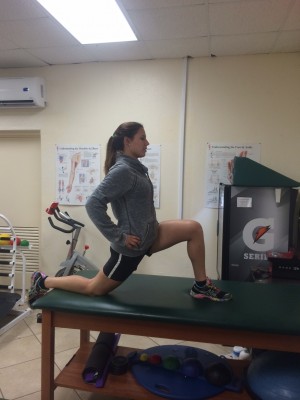
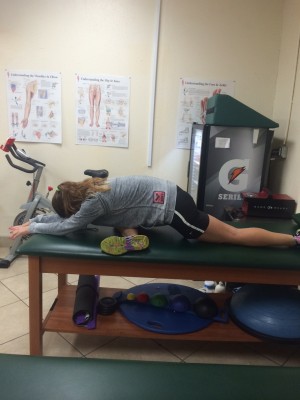
If after stretching these muscles the symptoms are not resolved, there may be some scar tissue forming in the area and ART massage would be indicated. Although painful, ART will help in breaking up any adhesions in the piriformis which are restricting the normal function of the sciatic nerve. There can also be a leg length discrepancy caused by tight hip muscles which can be released with manual therapy. If the leg length discrepancy is congenital, then a heel lift with the necessary measurements can be inserted into your cleat.
MUSCLE IMBALANCES
Sciatica can also be caused due to muscle imbalances in the hip area which cause the piriformis and hamstrings to work harder in an effort to compensate for areas of weaknesses. This can be corrected by completing the exercises listed in 7 exercises to treat and cure IT band syndrome. It can also be addressed by adding squats, walking lunges, reverse lunges, single leg dead lift, and hip abduction to your workout regime, twice a week. By strengthening these hip muscles it will correct compensation patterns and release the tension in the hamstring and piriformis caused by overworking them. In turn, the sciatic nerve is relieved from compression.
In following these tips the causes for sciatica can be resolved and you can return to riding pain free.
Written by: Dyani Herrera
Hip Rehab Program for Cyclists

Looking for a program that will help you address the muscle imbalance that is likely causing your sciatica? Look no further than Dynamic Cyclist. This comprehensive resource addresses the most common muscle imbalances and adaptive muscle shortening that lead to pain and reduced performance on the bike. With just 15 minutes a day, you can follow along with the video programs to alleviate tension and improve posture, so you can ride pain free and reach your full potential on the bike. Try out their 6 Week Functional Rehab Program and experience the results for yourself. Click here to try 7 days free!
